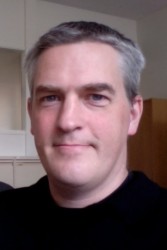Schedule
Nov. 30th
10:00 - 19:00 Preparation of demos
|
On the 30th November at approximately 6.30pm we are going to gather for an informal trip to the beach.
If anyone would like to join us please meet at the foyer of the conference presentation venue.
(Hawk Building at City West Campus)
|
Dec. 1st
8:00 Registration starts.
9:00 - 9:30 Opening
9:30 - 10:00 Demo Teasers
10:00 - 11:00
Session 1: System Design (3 papers)
11:00 - 11:20 break
11:20 - 12:20
Session 2: CG & Innovative Display (3 papers)
12:20 - 13:30 Lunch
13:30 - 14:30
Session 3: Input/Output (3 papers)
14:30 - 15:30 Transport
15:30 - 17:00
Demos (6 demos)
17:00 - 18:00 Reception
Dec. 2nd
9:00 - 10:00
Keynote Talk 1
10:00 - 10:20 break
10:20 - 11:00 Poster&LBR Teasers
11:00 - 12:20
Session 4: Wearable (4 papers)
12:20 - 13:30 Lunch
13:30 - 14:30
Session 5: Tracking (3 papers)
14:30 - 16:00
Posters &
Late Breaking Results (14 posters & 4 LBRs)
16:00 - 17:00
Session 6: Spatial AR (3 papers)
18:00 - 20:00 Banquet
Dec. 3rd
9:00 - 10:00
Keynote Talk 2
10:00 - 10:20 break
10:20 - 12:00
Session 7: 3DUI (5 papers)
12:00 - 12:30 Closing & Award Ceremony
Because there are serious difficulties of booking hotel rooms on December 3rd,
ICAT2010 will close around noon on the day so that participants can fly back in the afternoon or night of December 3rd.
Papers
Session 1: System Design (Dec. 1st, 10:00 - 11:00)
Chair: Nobuchika Sakata (Osaka University)
-
A Generic Model for Embedding Users' Physical Workspaces into Multi-Scale Collaborative Virtual Environments
Cedric Fleury, Alain Chauffaut, Thierry Duval, Valerie Gouranton and Bruno Arnaldi
-
Creating Instructional Content for Augmented Reality based on Controlled Natural Language Concepts
Steffen Mader and Bodo Urban
-
Service-Field Simulator using MR Techniques: Behavior Comparison in Real and Virtual Environments
Jungwoo Hyun, Yoshiko Habuchi, Anjin Park, Tomoya Ishikawa, Masakatsu Kourogi and Takeshi Kurata
Session 2: CG & Innovative Display (Dec. 1st, 11:20 - 12:20)
Chair: Hideo Saito (Keio University)
-
Synchronization-Free Parallel Collision Detection Pipeline
Quentin Avril, Valerie Gouranton and Bruno Arnaldi
Best Presentation Award
-
Multi-Dimensional Effects in Galvanic Vestibular Stimulations through Multiple Current Pathways
Taro Maeda, Yuki Miyata, Hiroyuki Iizuka and Hideyuki Ando
-
System and Users' Responses of Touch Light Through the Leaves: A Tactile Display for Light and Shadow
Kunihiro Nishimura, Yasuhiro Suzuki and Michitaka Hirose
Session 3: Input/Output (Dec. 1st, 13:30 - 14:30)
Chair: Roshan Lalintha Peiris (National University of Singapore)
-
Ubiquitous Character Input Device Using Multiple Acoustic Sensors on a Flat Surface
Akira Urashima and Tomoji Toriyama.
-
Aurally Presentation Technique of Virtual Acoustic Obstacle by Manipulation of Head-Related Transfer Function
Takahiro Miura, Junya Suzuki, Teruo Muraoka and Tohru Ifukube
-
Slow Motion Replay of Tactile Sensation
Yuki Hashimoto and Hiroyuki Kajimoto
Session 4: Wearable (Dec. 2nd, 11:00 - 12:20)
Chair: Ross Smith (University of South Australia)
-
Physiological Tracking, Wearable Interactive Systems, and Human Performance
Richard J. N. Helmer, Michael A. Mestrovic, Ken Taylor, Bodhi Philpot, Danielle Wilde and Damian Farrow
-
A Feasibility Study of Adopting Wireless Video for Wearable Computing
Ivan Lee, Zhenglin Wang and Bruce H. Thomas
-
Spatial Voice Menu and Head Gesture Interaction System for a Wearable Computer
Taiki Saito, Yasushi Ikei, Koichi Hirota and Michitaka Hirose
-
Stabilization Method for Floor Projection with a Hip-Mounted Projector
Keisuke Tajimi, Keiji Uemura, Yasuhiro Kajiwara, Nobuchika Sakata and Shogo Nishida
Best Paper Award
Session 5: Tracking (Dec. 2nd, 15:00 - 16:00)
Chair: Takeshi Kurata (AIST)
-
PTAMM-Plus: Refactoring and Extending PTAMM
Thanh Nguyen, Christian Sandor and Jun Park
-
Efficient Inter-camera Management for Multiple Objects Tracking in Mobile AR Environments
Woonhyuk Baek and Woontack Woo
-
A Metric for Tracking Robustness in Real-Time Panorama Acquisition
Christopher Coffin, Sehwan Kim and Tobias Hollerer
Session 6: Spatial AR(Dec. 2nd, 16:00 - 17:00)
Chair: Woontack Woo (GIST)
-
Tool Virtualization and Spatial Augmented Reality
Michael R. Marner and Bruce H. Thomas
-
Spatial Augmented Reality for Interactive Rapid Prototyping
Shane R. Porter, Michael R. Marner, Ross T. Smith, Joanne E. Zucco, Bruce H. Thomas and Peter Schumacher
-
An Audio Visual Projection System for Virtual Room Inhabitants
Jochen Ehnes
Session 7: 3DUI (Dec. 3rd, 10:20 - 12:00)
Chair: Christian Sandor (University of South Australia)
-
Teleporting in Virtual Worlds while Learning Real World Places
Shawn Kerns, Daniel Cliburn and Michael O'Rourke
-
Spatial Switching between Shared and Private Modes in Remote Cooperative Work with Mixed Reality
Ginga Kamei, Takeshi Matsuyama and Ken-ichi Okada
-
Comparison of Co-located and Remote Collaborative Work using a Stereoscopic Image on Path Steering Task
Satoshi Mieda, Tokuo Yamaguchi, Kazuki Takashima, Yoshifumi Kitamura, Anatole Lecuyer and Fumio Kishino
-
A Study of Perception of Volumetric Rendering for Immersive Scientific Visualization
Nan Wang, Alexis Paljic and Philippe Fuchs
Best Student Paper Award
-
A SURF-based Natural Feature Tracking System for Origami Recognition
Kening Zhu, Owen Noel Newton Fernando, Adrian David Cheok, Mark Fiala, Theam Wei Yang and Hooman Aghaebrahimi Samani
Posters (Dec 2nd, 10:20-11:00(Teasers) 13:30-15:00(Core Time))
-
Basic Study on Intelligently Haptic Controllable Shoes with Magnetic-Field Sensitive Gel
Takehito Kikuchi, Yasunobu Masuda, Tetsu Mitsumata and Suguru Ohori
-
Basic Study of Human factor on Cognitive Behavior for Driving Simulater
Noboru Takahashi, Shunzi Shimizu, Yukihiro Hirata, Hiroyuki Nara, Fumikazu Miwakeichi, Nobuhide Hirai, Senichiro Kikuchi, Eiju Watanabe and Satoshi Kato
-
Interactive Sound Creation System with Depth Camera
Hiroyo Ishikawa, Takeki Ihara, Takuya Ujihara and Hideo Saito
-
Analysis for Induced Movement using a Measurement System of Dynamic Posture Behavior
Takashi Imamura, Hiroyuki Tominaga, Zhong Zhang, Tetsuo Miyake and Kiyoaki Kakihara
-
Depth Camera to Generate On-line Content for Auto-Stereoscopic Displays
Francois de Sorbier, Yuko Uematsu and Hideo Saito
-
Prediction of Visually Perceived Depth of Virtual Objects from Observerfs Action Using Approximation Obtained by Gaussian Function
Kazutake Uehira, Minoru Yokono and Masahiro Suzuki
-
Detection and Transmission of "Tsumori": an Archetype of Behavioral Intention in Controlling a Humanoid Robot
Masataka Niwa, Shinya Okada, Shota Sakaguchi, Kentaro Azuma, Hiroyuki Iizuka, Hideyuki Ando and Taro Maeda
-
Effect of Wide FOV and Image Stabilization on Spatial Perception for View Sharing System
Daisuke Kondo, Kyo Hattori, Keitaro Kurosaki, Hiroki Kawasaki, Yuki Hashimoto, Tomoko Yonemura, Hiroyuki Iizuka, Hideyuki Ando and Taro Maeda
-
Annotation View Management for Wearable Projection
Keiji Uemura, Keisuke Tajimi, Yasuhiro Kajiwara, Nobuchika Sakata, Mark Billinghurst and Shogo Nishida
-
Remote Museum Guidance using Augmented Reality Vehicle
Atsushi Hiyama, Tomoaki Imai, Tomohiro Tanikawa and Michitaka Hirose
-
weather-vox central: Promotion of Mood Sharing by Extraction of Mood Information from Voice and Presentation to a Shared Space
Sho Sakurai, Takatsugu Kuriyama, Takuji Narumi, Yasuo Kuniyoshi, Masato Sasaki and Michitaka Hirose
-
AmbiKraf - Ubiquitous Fabric Display
Roshan Lalintha Peiris, Mili John Tharakan, Owen Noel Newton Fernando and Adrian David Cheok
-
Sound and Vibration Integrated Cues for Presenting a Virtual Motion
Taiki Saito, Yasushi Ikei, Tomohiro Amemiya and Koichi Hirota
-
The Research of Light-Weighted Finger Haptic Device using Voice Coil
Katsuhito Akahane, Chenxi Yu, Xiangning Liu and Makoto Sato
Demos (Dec 1st, 9:30-10:00(Teasers) 15:30-17:00(Core Time))
-
Large Scale SAR Prototypes for the Industrial Design Process
Markus Brocker and Ross T. Smith
-
Visualizing Environmental Corrosion in Mobile Augmented Reality
James A. Walsh and Bruce H. Thomas
-
Supporting the Industrial Design Process With Spatial Augmented Reality
Shane R. Porter, Ross T. Smith and Bruce H. Thomas
-
Digital Airbrushing with Spatial Augmented Reality
Michael R. Marner
-
Augmented Viewport: An Action at a Distance Technique for Outdoor Augmented Reality using Wearable Computers
Thuong N. Hoang, Ross T. Smith and Bruce H. Thomas
-
AR Dictionary: Dynamic Annotation for English Words in Printed Documents
Yuichiro Fujimoto, Chu Cheng Tse, Makoto Fujisawa, Toshiyuki Amano, Jyun Miyazaki and Hirokazu Kato
Late Breaking Results (Dec 2nd, 10:20-11:00(Teasers) 13:30-15:00(Core Time))
-
ARPipes: Aligning Virtual Models to their Physical Counterparts with Spatial Augmented Reality
Benjamin Close, Daniel B. McCulley and Bruce H. Thomas
-
A Fast Simulation Method Using SPH and Wavelet for Turbulent Flow
Makoto Fujisawa and Hirokazu Kato
-
Adding Sound to Silent Video by Identifying Corresponding Motion Vectors
Tomoya Hirose, Miwa Nishimura, Tsuyoshi Kobayashi, Jun Murayama, Yukihiro Hirata, Tetsuya Harada and Makoto Sato
-
Enabling Interoperability between 3D Formats through a Generic Architecture
Rozenn Bouville Berthelot, Jerome Royan, Thierry Duval and Bruno Arnaldi

